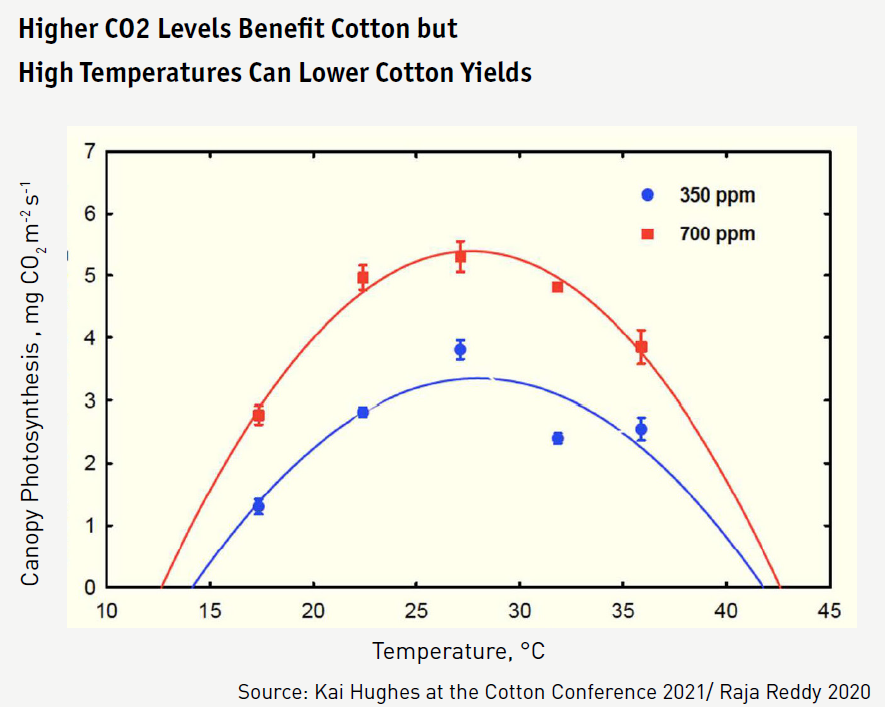
Interview with Kai Hughes, Director of the International Cotton Advisory Committee (ICAC) in Washington
Ongoing climate change is having an impact on agricultural production systems – including cotton cultivation. Kai Hughes, Director of the International Cotton Advisory Committee (ICAC) in Washington, answers the Cotton Report editorial team’s most important questions about cotton and climate change. Under the title “Climate change – a storm in a teacup?”, he had already given a presentation on the topic at the International Cotton Conference 2021.
Bremen Cotton Report: Climate change will have impacts on how and where cotton will be grown in the future. What are the fundamental changes that will affect cotton?
Kai Hughes: Climate change causes elevated CO2, elevated temperature and disruption in rain patterns, all of which are known to seriously influence cotton production. While increased levels of CO2 could benefit cotton, higher temperatures and erratic rainfall will significantly depress production. Rainfed cotton will be worst hit due to disrupted rain patterns and more than half of the global cotton area is under rainfed cotton. More than 95 percent of the cotton area in Africa and Brazil is rainfed. The rest of the rainfed cotton area is in India and United States, where 65 percent of the cotton acreage is fully dependent on rainfall. The fundamental changes that are likely to affect cotton are expected to be increased pestilence of a few insect pests and diseases coupled with decreased yields and fibre quality.
How can farmers adapt to these changes?
Cotton is basically a climate resilient crop. It is more resilient to dry conditions compared to most crops. Farmers in hot and dry regions of the world prefer cotton because of its resilience to climate risks. However, it is possible to further strengthen this innate resilience through science. There are two major strategies that can assist farmers to adapt to climate change. The first strategy is to breed climate-resilient cotton varieties, especially with tolerance to high temperatures. The second strategy is to rejuvenate soil organic matter and soil health through regenerative practices. Soils that are rich in organic matter capture and conserve rainwater more efficiently to help crops to tide over erratic rain patterns and higher temperatures. Soils rich in organic matter reduce the need for chemical fertilizers thereby reducing greenhouse gas emissions from farms.

With respect to the whole production system, what is needed to be prepared?
Preparedness to combat the effects of climate change also includes strategies to mitigate greenhouse gas emissions in the production and supply chains. The use of nitrogenous fertilizers in cotton production, use of electricity, water, energy and highly hazardous chemicals in farms and factories and use of energy, chemicals and water in fabric maintenance are major contributors to GHGs and major concerns for the ecology and environment. Research must be focused on developing environmentally friendly and eco-friendly ‘alternative technologies’ which reduced dependence on fossil fuels; that contribute least to GHG emissions and also help crops to combat the harmful effects of climate change.
Maybe new to some, cotton can play a central role in mitigating climate change. Could you explain the science behind this?
All plants help to mitigate climate change effects because they absorb CO2. Cotton plants are more special because they not only absorb CO2 in the plant biomass like other plants, but they capture extra CO2 in their carbon-rich fibres. Cotton fibres are almost pure cellulose. Fibres contain 96-98 percent cellulose and 42 percent carbon. One Kilogram of cotton fibre sequesters 1.54 kg of CO2.
All agricultural crops emit greenhouse gases during production because of the use of energy, manures, fertilisers and pesticides. Cotton crop emits 1.7 kg of CO2 equivalent greenhouse gases per kilogram of fibre produced. But cotton also captures and stores greenhouse gasses in its fibres and in the soil, equivalent to 2.2 kg of CO2 per kg of fibre produced. Thus, cotton absorbs half a kilogram more greenhouse gases than it emits.
Cotton belongs to a photosynthetic category called C3 crops such as Wheat, Rice Sunflower etc., unlike Sugarcane, Maize and Sorghum for example which are C4 crops. C3 crops can sequester almost double the levels of CO2 than C4 crops. In fact, the C4 crops cannot capture CO2 more than 415 ppm. Thus, as the CO2 continues to rise in the next 80 years to about 800 ppm, cotton crop will continue to serve the environment by continuing to absorb more and more CO2.
Thus, as the cotton crop in its current form continues to sequester more carbon than it emits to mitigate climate change effects, it is expected to perform better in systems that are least dependent on energy and are far less chemicals-intensive than the conventional systems of production and processing.
Thank you for the interview!
Find the conference presentation here: Kai Hughes – Climate Change: A storm in a teacup?
The interviews in the column “Question Time“ embody the opinion of the respective interview partner and do not represent the position of the Bremen Cotton Exchange as neutral, independent institution.

